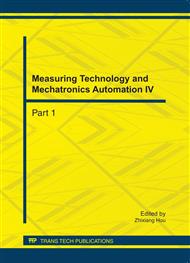[1]
Yang Liu, Hiroshi Matsuhisa and Hideo Utsuno, in: Semi-active vibration isolation system with variable stiffness and damping control, Journal of Sound and Vibration, 313(2008)16-28.
DOI: 10.1016/j.jsv.2007.11.045
Google Scholar
[2]
D. Karnopp, M.J. Crosby and R.A. Harwood, in: Vibration control using semi-active force generators, Journal of Engineering for Industry, 96(2) (1974)619-626.
DOI: 10.1115/1.3438373
Google Scholar
[3]
S. Rakheja and S. Sankar, in: Effectiveness of on-off, damper in isolation dynamical systems, Shock and Vibration Bulletin, 57(1986)147-156.
Google Scholar
[4]
J. Alanoly and S. Sankar, in: A new concept in semi-active vibration isolation, American Society of Mechanical Engineers, Journal of Mechanisms, Transmissions and Automation in Design, 109(1987)242-247.
DOI: 10.1115/1.3267444
Google Scholar
[5]
X. Wu and M.J. Griffin, in: A semi-active control policy to reduce the occurrence and severity of end-stop impacts in a suspension seat with an electro-rheological fluid damper, Journal of Sound and Vibration, 203(5) (1997)781-793.
DOI: 10.1006/jsvi.1996.0901
Google Scholar
[6]
L.M. Jansen and S.J. Dyke, in: Semi-active control strategies for MR dampers: a comparative study, American Society of Civil Engineers, Journal of Engineering Mechanics, 126(8) (1999)795-803.
DOI: 10.1061/(asce)0733-9399(2000)126:8(795)
Google Scholar
[7]
D.C. Karnopp, in: Design principles for vibration control systems using semi-active dampers, American Society of Mechanical Engineers, Journal of Dynamic Systems, Measurement and Control, 112 (1990)448-455.
DOI: 10.1115/1.2896163
Google Scholar
[8]
J. Alanoly and S. Sankar, in: Semi-active force generators for shock isolation, Journal of Sound and Vibration, 126(1) (1988)145-156.
DOI: 10.1016/0022-460x(88)90404-x
Google Scholar
[9]
Y. Liu, T.P. Waters and M.J. Brennan, in: A comparison of semi-active damping control strategies for vibration isolation of harmonic disturbances, Journal of Sound and Vibration, 280 (2005)21-39.
DOI: 10.1016/j.jsv.2003.11.048
Google Scholar


